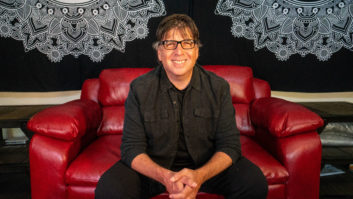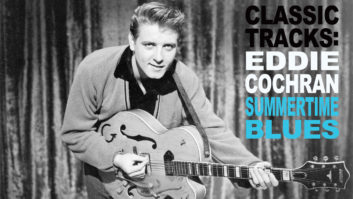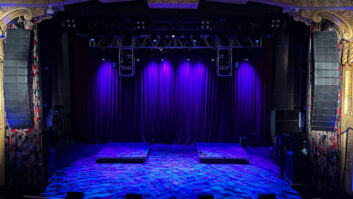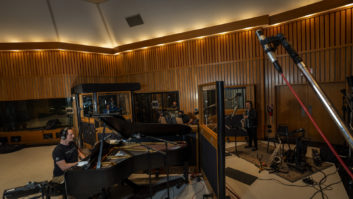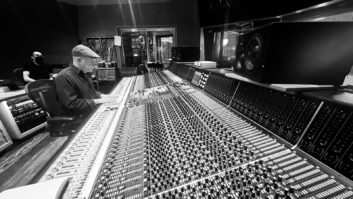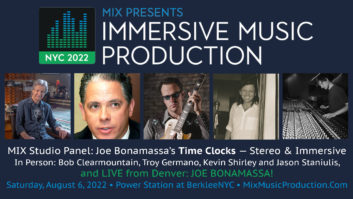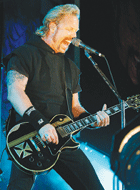
Metallica’s James Hetfield
File this one under, “It’s always somethin’, Jane.” For once, the talk of the music industry isn’t declining CD sales — it’s declining concert ticket sales. After what many analysts believe was the worst summer for touring acts, promoters and venues in several years, there’s been a lot of head-scratching, soul-searching and finger-pointing; in other words, it’s business as usual in this notoriously fickle and unpredictable industry.
“It was a down year depending on who you talk to — as much as 25 percent off or more,” says Billboard‘s senior touring writer Ray Waddell. “The reasons why are many, but it could be that this is the year ticket prices reached critical mass with consumers. When you combine that with the fact that so much of the touring is crammed between April and September and the same acts are going out year after year, that spells a downturn eventually.”
“In general, we saw, nationally, a sharp drop-off in ticket sales in mid-April that seemed to affect just about every tour out there,” adds Gary Bongiovanni, editor in chief of Pollstar, a leading tracker of the touring industry. “I don’t think you can say it’s just high ticket prices or tours that people didn’t want to see. Ultimately, it’s something in the American psyche that makes people want to hold onto their money a little tighter. There was no one defining moment — like a September 11th — that you can point to, but there are a couple of outside things that seemed to be causal factors. One is that last spring, gas prices spiked to record levels everywhere. Also in mid-April, there was a huge jump in the number of soldiers killed in Iraq. Something intangible happens to people when they get to be insecure about their finances, their jobs, their futures and what’s happening in the world. If you’re going to pass on any expense, certainly a pair of $80 concert tickets is easy to give up,” he says, adding that this year’s surging ticket prices didn’t help. (According to Pollstar, ticket prices have nearly doubled since 1995.)

Shania Twain at the mic
Waddell adds that the season did have its successes. “Madonna, Prince and Shania Twain all did good business,” he says. “Country music in general did very well and one reason for that is [those tours were] priced better than the big rock shows. The ticket price for the biggest superstars in country music rarely tops $50 compared to $350 for Madonna. The Prince tour was very value-oriented. It was a 50-something-dollar ticket that included a CD, and it was advertised as a greatest-hits package and that worked.”
Multiple bill tours were also successful. “Nickelback with Three Doors Down and Puddle of Mudd did really well,” says Waddell. “Linkin Park and Projekt Revolution was big. Ozzfest continues to be strong. But [Vans] Warped [Tour] is probably the most value-oriented tour there is. You get something like 80 bands for 20 bucks; you can’t beat it. A few of the festivals have become well-established by now, too, like Coachella and Bonnaroo.”
TICKETING UPS AND DOWNS
For proof that the summer season was soft, one need look no further than the fact that Clear Channel, by far the nation’s top concert promoter, chose to offer severely discounted tickets at many of the venues it controls and that other promoters followed suit. At Clear Channel’s three Northern California sheds, for instance, there was a one-day sale on all lawn seating tickets for just $20 and that added hundreds of thousands of dollars to the company coffers. There is an inherent risk in those sorts of price breaks, however.
“Part of the problem for the sheds,” Bongiovanni says, “is that you’ve pushed these ticket prices up steadily, and along with it the lawn prices have gone up, and I don’t know if the public is buying the proposition that you should have to spend $40 or $50 to sit in the back on a lawn, especially when you talk about an older crowd. So you get the two-for-one sales, $20 tickets, all those kinds of things to sell more. The real problem with that, though, is that it trains your audience to not buy tickets in advance but wait for the deal that’s coming later. That’s very dangerous.” (Clear Channel declined to have a rep interviewed for this article.)

Madonna re-invents herself yet again during the 2004 Re-Invention tour.
The most notable disaster of the summer was the cancellation of the Lollapalooza tour, which, Bongiovanni says, looked problematic from the start. “Basically, they had a great bill about 10 years too late,” he says. “When you’re talking about a two-day show that’s going to be an all-day experience, you’re really relying on kids to fill the place and that tour was not aimed at kids. Your Morrissey and P.J. Harvey fans are older and would rather see those acts in a smaller venue. They don’t want to spend all day outdoors anymore.”
SR COMPANIES ROLL WITH THE PUNCHES
Of course, a cancellation of that magnitude — and the slump in general — don’t just affect the bands, promoters and venues, but also the sound reinforcement companies that are taking those tours from city to city.
“We definitely had a bad string of luck this summer,” says M.L. Procise, senior VP of sales with Showco/Clair, one of the largest touring sound companies in the world. “We had Lollapalooza, Britney Spears and Christina Aguilera, all of which cancelled, so we lost $1 million of summer revenue in a one-month period. But we still managed to squeak out a decent year. But touring in general is in a bad state of affairs for many companies.”
Why? “What has seemed to happen is that the largest promoter has reduced the touring season from May to September because their assets lie in the ownership of indoor/outdoor amphitheaters: the sheds. From what I understand, they are paying artists higher guarantees to lock up the available tours and thus command a higher ticket price. They’re cannibalizing the available money of the average person to go see a concert by sticking too many artists in too small a touring season. But the touring season being so crowded is hurting some of the people in this business.”
Procise, a 30-year veteran of Showco and one of the most respected voices in the industry, adds, “When you’re a service company, you have to push the envelope during the summer months to get as high a utilization of your equipment as possible, because you’ve got to get through the winter months when there is a small amount of touring. Not only are we stretching our resources to the maximum, it’s putting us in the position where it’s hard to service all the clients in the summer at the level they should be serviced at. Everybody wants the best people and the best equipment, and that’s harder to do when everyone is going out at the same time.”

Less Than Jake at 2003’s Vans Warped Tour
Showco/Clair is positioned better than many companies to deal with this issue. The company prides itself on its huge equipment inventory — many millions have been spent on keeping multiple Showco Prism and Clair I-4 systems up-to-date and in top shape, and millions more have been invested in the latest digital and digitally controlled analog consoles — and gear is standardized. “Whether you’re doing a club tour or a stadium tour, you’re getting the same equipment the big boys get,” says Procise. “That’s a huge plus for our client base.”
Procise dismisses concerns by some industry observers that with its merger, Showco/Clair has become too big, that service will inevitably suffer and competition be crushed along the way. “Whether [regional sound companies] know it or not, we’re giving them a lot of work they might not get ordinarily. I refer calls to local sound companies all the time. A lot of those people are my friends. We have not hurt the regional sound companies in any way, shape or form; in fact, I think we’ve strengthened some of them.”
Over at Rat Sound, which handles a broad range of big tours (R.E.M., Pearl Jam, Curiosa, Ben Harper, et al), small tours and one-offs, company founder Dave Rat notes, “Believe it or not, business has been great compared to last year. This year, we didn’t really get going until June, which is the latest start we’ve ever had. But now this is the strongest tail end of the year we’ve ever had. And we’re also looking at a good 2005 because some of our major, historically strongest clients are all either coming out with albums or scheduling tours through the end of this year and into next year.”
Rat says that when the touring business looked like it was going to be slow in 2004, focus shifted toward regional and local shows. “It took us a little while to ramp up for that,” he says. “The pressure there is more in the realm of personnel because we had to rely more on locally based people in addition to our own staff. The biggest challenge was keeping everyone together and getting enough manpower to get these shows out, because it’s almost the same amount of work to get a local show out as a tour, and if you have four [one-offs] a week, it’s a tremendous amount of work.”

Kenny Chesney and country music tours found
success, in part, due to lower ticket prices.
Rat Sound has a number of Rat Trap 5 and V-DOSC systems, but Rat notes, “Our attitude is, ‘What do you want?’ If we have it, cool; if we don’t, we’ll bring it in. I find that a lot of times, [bands/tours] are more concerned about the people than the system.” As for trends in equipment requests, Rat notes digital consoles are gaining acceptance as designs evolve. “People want that computer control, but they don’t want some laptop [system] because the software boot-up time is unacceptable. They want big buttons and fast, easy-to-use gear that isn’t going to break. As the manufacturers get closer to that [in their digital console designs], they’re becoming more accepted. They act less like a computer and more like an analog board or a piece of gear we can use.”
DIVERSIFYING: GEAR AND GIGS
For Paul Owen’s sound company, Thunder Audio, (Detroit) one way around the uncertainty of the touring business was to get into more corporate work. “The corporate world has changed,” says Owen. “It used to be handled separately from the people who did the live rock ‘n’ roll touring. It used to be that the corporate side was where all the good money was made, too, because you could charge them corporate prices. They used to attack these [corporate] shows as if they were doing a permanent install, taking four or five days to put the thing in and a couple of days to take it out, and then the client would wonder why the billing was so high. But that’s changing. There’s more of the rock ‘n’ roll mentality now: Putting it in one day and taking it down that night and, of course, that’s affected prices, as well. On the Metallica tour I’m on right now, we have 14 trucks and we load in at 9 a.m. with rigging and we’re out in two hours at night.
“I think people are being a little more conscious about streamlining,” Owen continues. “More conscious about the truck space and weight, efficiency with line array systems — all those kinds of things.” When it’s noted that 14 trucks doesn’t exactly sound like streamlining, Owen says, “Yeah, that’s true,” with a laugh, “but only two trucks of that is audio. A lot of it is this really huge stage and the lights, but it’s in the round so it is a large configuration of speakers.” Owen notes that purchasing his own semis for equipment transportation has also been economical.
Another hedge against the slow touring year in America has been getting acts to play in Europe. Owen says, “With the exchange rate on the dollar, you’ll find a lot of bands concentrating on Europe now because they can get much more bang for the buck. The economies are so strong over there and the bands are getting paid in Euros. If you go over there and do two or three months, it’s cheap enough to bring American production over there. Whereas there used to be only certain shows for bands like Metallica and Marilyn Manson, now there are so many of them and the festival season is three or four months. At Rock in Rio in Lisbon this year, they pulled in $70,000 a day for a whole week with different headliners each night.”
At Dallas-based Crossroads Audio, company-wide diversification has helped business remain robust in the face of an uncertain economy. “We had one of our best years,” says event services manager Mike Ponczek. “We do every kind of regional work you can imagine — touring and corporate work and special events of every size. We’ve latched onto some good clients in the past year such as the Sonic Drive-In food chain, who had LeAnn Rimes in the round, and Mary Kay cosmetics, who had a three-week convention in Dallas. We do dry rentals and, of course, other dates where we’ll supply the system, or part of it, and engineers and do the sound. We also record for the local classical station, WRR, for its Christmas concerts.”

LeAnn Rimes during her 2003 tour
Ponczek notes that for large concert productions, people expect a line array system or some large P.A. configuration. “We’ve chosen Meyer products as our benchmark: We have the M3D, M2D and the M1, which practically fit under your arms.” For consoles, “Most people are still requesting Midas consoles, Yamaha 4000 and 3500s. The [Yamaha PM-5D] hasn’t entered on any request of mine. However, in the touring world, the 5D would probably be the case.” He has also used the Yamaha DME 2000 at some recent shows.
Robert Hawthorne, of Birmingham, Ala., Muse Productions, says, “I think the [touring sound] market has always been cyclical. But one thing that’s changed over the years is that, 20 years ago, a company didn’t just go out and buy a system — you built it up from the ground. You couldn’t just walk in and plop down a chunk of change and buy a turnkey system. I see that happening more and more. Somebody will buy a big Meyer or V-DOSC rig. Those people will take a certain number of shows away, but one thing they can’t buy is the experience. I’ve seen people who have bought P.A.s like that that have great shows and then have horrible ones because they didn’t take care of the equipment and they don’t have the people who can really manage it.”
Asked if the increased competition in the SR business has led to downward pressure on prices, Hawthorne says, “Definitely, but that’s a temptation you have to try to avoid. Our product is not just the equipment, it’s the service, and a lot of our clients will pay us a premium for our services because they know they’re not going to have any problems. I’ve played chasing the market up and down in the past and it never worked. So I’ve held firm [on our prices] and we probably lost a couple of dates that we could have had, but I’ve had some people come back and say, ‘You know, you guys were a little more expensive, but we never had any problem with you before and we’ll be back.’ And by the end of the season, we were getting the work from them.”
Blair Jackson is the senior editor at Mix.
